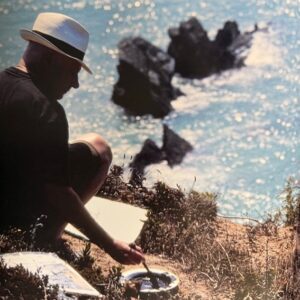by Wendy Davis Beard, writer
Decades ago, I skipped behind the British Australian artist John Beard as he was drawing the Adraga rock from the cliff top on the most westerly point of Portugal.
I was placing small rocks on top of thick handmade paper boards he had purchased in Madrid.
I anchored each unfinished work on paper in place to await a second, third or even fourth coat, of raw black pigment procured in the Antipodes and mixed with local tap water.
I swooped in after he painted each coat onto the surface, fortunately, none of the paper boards were whipped wildly away by the wind to the beach beneath us!
 His loaded brush, like one of the dark wet waves. licking the pyramid shaped rock in the sea below off the Atlantic coast of Adraga beach. He depicted a moment in time just before the swell of the sea withdrew, momentarily exposing the rough craggy surface of the rock face and the undergarments of the rock below the sea…
His loaded brush, like one of the dark wet waves. licking the pyramid shaped rock in the sea below off the Atlantic coast of Adraga beach. He depicted a moment in time just before the swell of the sea withdrew, momentarily exposing the rough craggy surface of the rock face and the undergarments of the rock below the sea…
While, It’s sharp angular rock top pinnacles always remained sharp and plainly evident to all, what’s not so easy to see, appreciate or anticipate, is how those very same images still framed uniformly from their last solo exhibition outing at Tate Gallery St Ives in 1994, relate so closely in structure, texture and spirit to the recent later- in- life colourful watercolours of roses growing both wild and cultivated in our garden in Devon, on the Somerset, Dorset border.
How can the rough and the smooth coexist ostensibly well in his studio and appear so melodiously connected when hung together on the sitting room wall?
What I assume about roses rolling gentle soft curves and the absence of sharp edges or points is confounded by this artist’s perception, which surprisingly echos his depiction of the angular Adraga rock. Is this a particular artist ’s vision a means of seeing everything in the same way? and when is a rose is a rose as Gertrude Stein often repeated?
What is the meaning of a rose is a rose?
Stein later used variations on the sentence in other writings, and the shortened form “A rose is a rose is a rose” is among her most famous quotations, often interpreted as meaning “things are what they are”, a statement of the law of identity, “A is A.” Gertrude Stein, 1935….the phrase originated in Gertrude Stein’s poem Sacred Emily in 1913.
Things are what they are…Or are they?
I am challenged by Beard’s perceptions, depictions and juxtapositions – to think and to look again.
Beard’s favourite quote by Paul Cezanne about painting Mount Mt Sainte Vitoire; “For a long time I was quite unable to paint Sainte-Victoire. I had no idea how to go about it
because, like others who just look at it,I imagined the shadow to be concave, where as in fact it’s convex,It disperses outward from the centre.” -Joachim Gasquet,Cezanne: A Memoir with conversations
While I no longer follow him on foot, I still shadow John in my electric wheelchair, and continue to doggedly document his work- in – progress as I have for the last forty years,
From Wendy Davis Beard’s ongoing memoir of recovery working title: Forever Forward, 2025.
